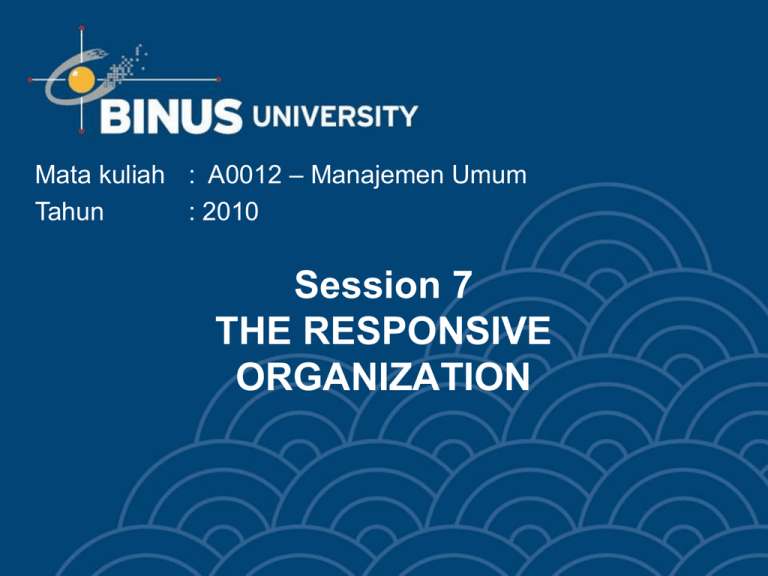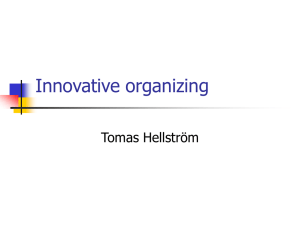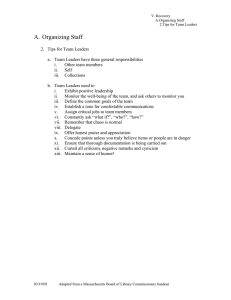Session 7 THE RESPONSIVE ORGANIZATION – Manajemen Umum
advertisement

Mata kuliah : A0012 – Manajemen Umum Tahun : 2010 Session 7 THE RESPONSIVE ORGANIZATION Learning Objectives • After studying Chapter 9, you will know: – – – – – – – – 9-2 the market imperatives a firm must meet to survive the potential advantages of creating an organic form of organization how a firm can “be” both small and big how to manage information-processing demands how firms manage information-processing demands how firms organize to meet customer requirements how firms organize around different types of technology the new types of dynamic organizational concepts and forms that are being used for strategic responsiveness Outline Materi • • • • • • Bina Nusantara Today’s Imperatives Organizing for Optimal Size Organizing for Environmental Response Organizing for Technological Response Organizing for Strategic Response Final Thoughts about Responsive Organizations Today’s Imperatives • Responsiveness – quickness, agility, and the ability to adapt to changing demands • Burns and Stalker – mechanistic structures - a form of organization that seeks to maximize internal efficiency – organic structure - an organization form that emphasizes flexibility • people work more as teammates than as subordinates • break away from the traditional bureaucratic form 9-4 Organizing For Optimal Size • Large organizations – tend to have more specialized jobs – are more difficult to control • adopt bureaucratic controls such as rules, procedures, and paperwork • The case for big – scale economies - lower costs per unit of production • lowered operating costs, easier access to capital, greater purchasing power – economies of scope - materials and processes used with one product can be used for other, related products – diseconomies of scale - cost of being too big 9-5 Organizing For Optimal Size (cont.) • The case for small – smaller companies can: • move fast • provide quality goods and services to targeted market niches • inspire greater involvement from their people – today, premium exists for flexibility and responsiveness • Being big and small – small is beautiful for unleashing energy and speed – large size offers market power – challenge is to be both big and small to capitalize on the advantages of each 9-6 • Downsizing Organizing For Optimal Size (cont.) – the planned elimination of positions or jobs – common approaches include eliminating functions, hierarchical levels, or units – rightsizing - a successful effort to achieve an appropriate size at which the company performs most effectively – survivor’s syndrome - loss of productivity and morale in employees who remain after a downsizing • • • • 9-7 struggle with heavier workloads wonder who will be the next to go try to figure out how to survive become narrow-minded and self-absorbed Easing The Pain Of Downsizing Carefully choose positions to be eliminated Emphasize a positive future Communicate constantly 9-8 Positive practices Train people how to cope Protect talented people Attend to those who have lost their jobs Organizing For Environmental Response • Organizing to manage information – huge amounts of information flow to and from the environment – Option one: Reducing the need for information • slack resources - extra resources which can be used “in a pinch” – e.g., inventory • creating self-contained tasks - change from a functional organization to a product or project organization – each unit has the resources needed to perform its task – communications flow within each team rather than among a complex array of interdependent groups 9-9 Organizing For Environmental Response (cont.) • Organizing to manage information (cont.) – Option two: Increasing information processing capability • invest in information systems - employing or expanding computer systems • create horizontal relationships - foster coordination across different units – horizontal processes include: » direct contact » liaison roles » task forces » teams » product, program, or project managers » matrix organization 9-10 Managing High Information-Processing Demands Reduce the need for information High information processing demands Process more information 9-11 Create slack resources Create self-contained tasks Invest in information systems Create horizontal relationships Organizing For Environmental Response (cont.) • Organizing for customer responsiveness – no other aspect of the environment has had a more profound impact on organizing recently than the focus on customers – strategic triangle - managers must balance this triangle Customers Corporation 9-12 Competitors Organizing For Environmental Response (cont.) • Organizing for customer responsiveness (cont.) – Customer Relationship Management (CRM) -multifaceted process • creates two-way exchanges with customers in order to learn their needs and buying patterns – traditional thinking - customers wanted high quality or low costs – kaizen - attain and retain competitive advantage by continuing to improve – customer - refers to the next process, or wherever work goes next • highlights interdependence among related functions 9-13 Organizing For Environmental Response (cont.) • Organizing for customer responsiveness (cont.) – Total Quality Management (TQM) - comprehensive approach to improving quality and customer satisfaction • characterized by a strong orientation toward internal and external customers • involves people across departments in improving all aspects of the business • requires integrative mechanisms that facilitate group problem solving, information sharing, and cooperation across business functions – Baldrige award - given to U.S. companies that achieve quality excellence 9-14 Organizing For Environmental Response (cont.) • Organizing for customer responsiveness (cont.) – ISO 9000 - a series of quality standards developed by a committee working under the International Organization for Standardization • intended to improve total quality in all businesses • companies that comply with standards entitled to certification – Reengineering - revolutionizes key organizational systems and processes • completely overhauls the operation • based on a vision for how the organization should run 9-15 Organizing For Technological Response • Technology – systematic application of scientific knowledge to a new product, process, or service – the methods, processes, systems, and skills used to transform resources (inputs) into products (outputs) • Types of technology configurations – Small batch technologies - produce goods and services in low volume • job shops • structure tends to be organic – few rules and formal procedures – decentralized decision making 9-16 Organizing For Technological Response (cont.) • Types of technology configurations (cont.) – Large batch technologies - produce goods and services in high volume • structure tends to be more mechanistic – – – – many more rules and formal procedures centralized decision making higher spans of controls more formal communication – Continuous process technologies - highly automated continuous production flow • structure can be more organic – less monitoring and supervision required – more informal communication 9-17 Organizing For Technological Response (cont.) • Organizing for flexible manufacturing – Mass customization - the production of varied, individually customized products at the low cost of standardized, mass-produced products • a dynamic network of relatively independent operating units • module - a specific process or task performed by a unit – different modules joined to make a good or service – combination of modules dictated by unique customer requests – Computer-integrated manufacturing (CIM) - use of computer-aided design and computeraided manufacturing to sequence and optimize a number of production processes – team members work on the network from remote sites – provides maximum process flexibility 9-18 Organizing For Technological Response (cont.) • Organizing for flexible manufacturing (cont.) – Flexible factories - differ from traditional factories • have much shorter production runs, with different products • organized around products in work cells or teams • use local or decentralized scheduling – Lean manufacturing - operation that strives to achieve the highest possible productivity and total quality, cost effectively, by eliminating unnecessary steps in the production process and continually strives for improvement 9-19 Organizing For Technological Response (cont.) • Organizing for speed: Time-based competition (TBC) – time is emerging as a key competitive advantage that can separate market leaders from alsorans – TBC - strategies aimed at reducing the total time it takes to deliver a product or service – Logistics - the movement of resources into the organization (inbound) and products from the organization (outbound) • an extension of the organization’s technology configuration • a great mass of parts, materials, and products moving via trucks, trains, planes, and ships 9-20 Organizing For Technological Response (cont.) • Organizing for speed: Time-based competition (cont.) – Just-In-Time (JIT) - system that calls for subassemblies and components to be manufactured in very small lots and delivered to the next stage of the production process just as they are needed • a company-wide philosophy oriented toward eliminating waste throughout all operations and improving materials throughout – excess inventory is eliminated – costs are reduced 9-21 Production Concepts Included In JIT Perfect quality Elimination of waste Problem discovery and prevention Value-added manufacturing 9-22 JIT Reduced cycle times Employee involvement Organizing For Technological Response (cont.) • Organizing for speed: Time-based competition (cont.) – Simultaneous engineering - a design approach in which all relevant functions cooperate jointly and continually in maximum effort aimed at producing high-quality products that meet customers’ requests • departure from old development process in which tasks were assigned to various functions in sequence • incorporates the issues and perspectives of all functions - and customers and suppliers - from the beginning of the process 9-23 Organizing For Strategic Response • Organizing around core competencies – companies compete on the basis of their core strengths and expertise • core competence - the capability - knowledge, expertise, skill - that underlies a company’s ability to be a leader – company viewed as a portfolio of competencies – company should strive for core competence leadership by: • identifying existing core competencies • acquiring or building core competencies that will be important in the future • investing in competencies in order to remain world-class • extending competencies 9-24 Organizing For Strategic Response (cont.) • The network organization – a collection of independent, mostly single-function firms – not one organization, but a web of interrelationships among many firms – dynamic network (modular or virtual corporation) - temporary arrangement among partners that can be assembled and reassembled to adapt to the environment • contracts stipulate expected results • offers flexibility, innovation, quick responses, and reduced costs and risks • managers become brokers – play several important boundary roles 9-25 Organizing For Strategic Response (cont.) • Strategic alliances – a formal relationship created among independent organizations with the purpose of joint pursuit of mutual goals – individual organizations: • share administrative authority • form social links • accept joint ownership – managers must foster and develop the human relationships in the partnership 9-26 Organizing For Strategic Response (cont.) • The learning organization – an organization skilled at creating, acquiring, and transferring knowledge – modifies its behavior to reflect new knowledge and insights • High-involvement organization – top management ensures that there is consensus about the direction of the business • • • • 9-27 seeks input from lower-levels of the company techniques used to foster participation in decision making continual feedback to participants flat, decentralized structure built around customer, product, or service

